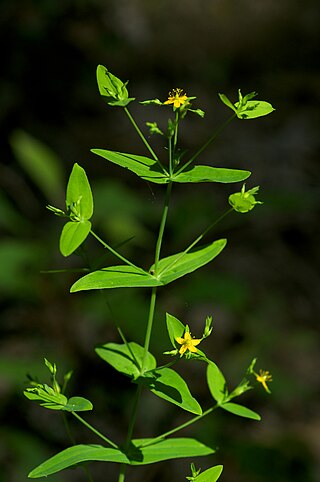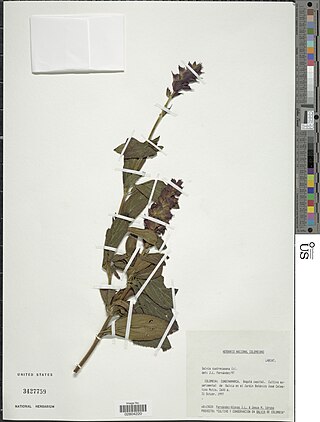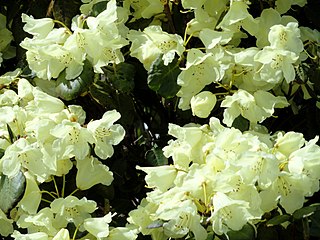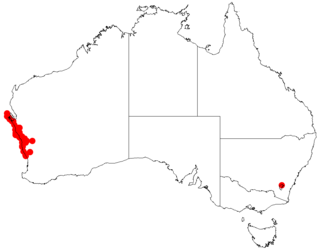
Nepenthes rigidifolia is a critically endangered tropical pitcher plant endemic to Sumatra, where it grows at elevations of 1000–1600 m above sea level.

Mangifera zeylanica or "Sri Lanka wild mango" is a wild species of mango tree endemic to Sri Lanka. This stately tree is the tallest member of the mango genus, Mangifera, and one of the two tallest trees in the family Anacardiaceae. The mango fruits are edible and have an excellent taste. It is called "aetamba" (ඇටඹ) or "wal amba" in Sinhala and “kaddu-ma” in Tamil. The well-known British botanist and explorer Joseph Dalton Hooker first described the tree in 1876.

Hypericum mutilum is a species of St. John's wort known by the common name dwarf St. John's wort. It is native to parts of North America and is present in other parts as an introduced species. It is an annual or perennial herb taking a multibranched erect form up to about 60 centimeters tall. The oval green leaves are one or two centimeters long and are covered in tiny glands. The inflorescence is a compound cyme of tiny flowers. H. mutilum subsp. mutilum and subsp. boreale have a diploid number of 16, and H. mutilum subsp. boreale can have a diploid number of 18.

Salvia cuatrecasasiana, first described as Salvia cuatrecasana, is a perennial shrub that is endemic to a few small areas in Colombia, growing at 2,800 to 3,500 m elevation on roadsides, streamsides, and disturbed areas.

Alangium polyosmoides is a rainforest tree of eastern Australia. It occurs on a variety of different soils, generally close to the coast. Found from Minmi near Newcastle to as far north as the McIlwraith Range in far northeastern Queensland. It may be seen as a common understorey plant at Wingham Brush Nature Reserve.

Rhododendron campylocarpum is a rhododendron species. It is native to eastern Nepal, Sikkim, Bhutan, Arunachal Pradesh, southeastern Tibet, and southwestern China, where it grows at altitudes of {{Cvt|3000–4000 meters. It is a shrub that grows to 2–3 m in height, with leathery leaves that are suborbicular or ovate-elliptic to oblong-elliptic, 4–8.5 cm (1.6–3.3 in) long by 2.5–4 cm (1.0–1.6 in) wide. Its flowers are yellow. It is placed in section Ponticum.

Astragalus alopecurus, synonym Astragalus centralpinus, is a species of milkvetch in the family Fabaceae.

Ipomoea oenotherae is a species of plant of the morning glory genus, Ipomoea, in the family Convolvulaceae. It derives its name from the resemblance it bears to plants in the genus Oenothera. Ipomoea oenotherae is a succulent and a cryptophyte.

Malaxis seychellarum is a species of orchid endemic to the Seychelles Islands in the Indian Ocean. First described in 1902, it is now considered a vulnerable species.

Acacia gregorii, commonly known as Gregory's wattle, is a shrub belonging to the genus Acacia and the subgenus Phyllodineae native to Western Australia.

Acacia idiomorpha is a shrub belonging to the genus Acacia and the subgenus Phyllodineae that is endemic to a small area of western Australia.
Hypericum cuisinii is a perennial herb in the genus Hypericum, in the section Adenosepalum. The herb has pale yellow flowers and occurs in Greece and Turkey.

Festuca brachyphylla, commonly known as alpine fescue or short-leaved fescue, is a grass native to Eurasia, North America, and the Arctic. The grass is used for erosion control and revegetation. The specific epithet brachyphylla means "short-leaved". The grass has a diploid number of 28, 42, or 44. This species was first described in 1827.
Polygala bifoliata is a species of flowering plant in the milkwort family (Polygalaceae), which was first described in 2012 by Raelee Kerrigan. It is endemic to the Northern Territory and Western Australia.
Gutenbergia rueppellii is an African species of flowering plant in the family Asteraceae.

Itoa orientalis is a species of flowering plants belonging to the family Salicaceae. An evergreen tree from China and Vietnam, and cultivated as an ornamental tree.
Nathaliella is a monotypic genus of flowering plants belonging to the family Scrophulariaceae. The only species is Nathaliella alaica. It is also within Tribe Scrophularieae.
Hedinia is a monotypic genus of flowering plants belonging to the family Brassicaceae. It only contains one known species, Hedinia tibetica.

Crateva tapia, commonly known as toco, payaguá, naranjuelo, or beach apple, is a member of the genus Crateva, belonging to the family Capparaceae. It is native from Mexico through Central America into South America as far as south Brazil.

Reinwardtiodendron anamalaiense, is a species of flowering plant within the genus Reinwardtiodendron and family Meliaceae. It is an evergreen tree species native to India, where it is endemic to the Western Ghats. It is one of six known species within the genus Reinwardtiodendron.














